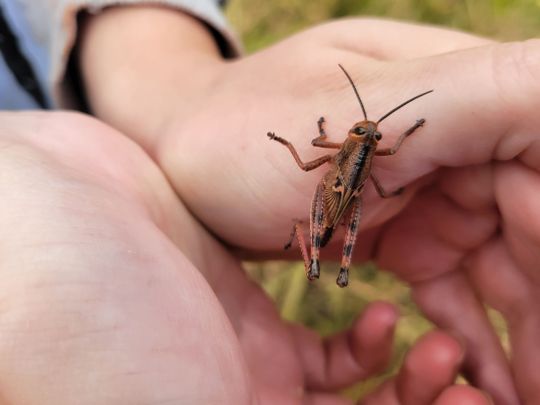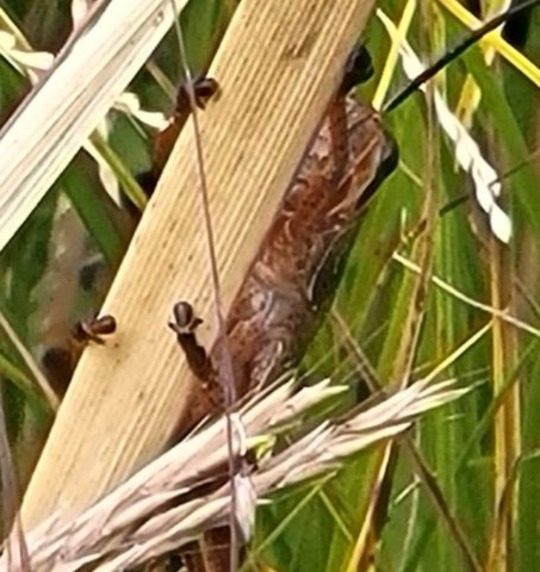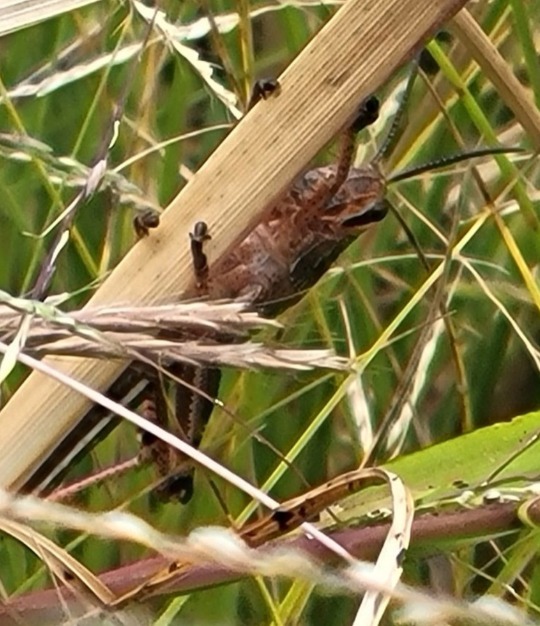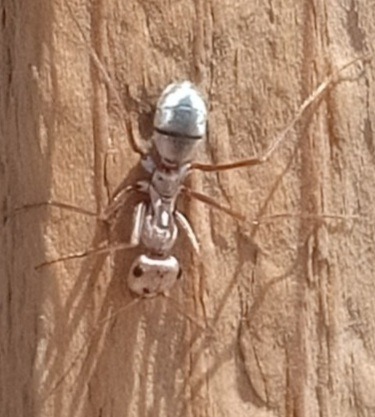#inaturalist gave me very vague options
Explore tagged Tumblr posts
Text
Doing grass surveys does have one perk: lots of beautiful grasshoppers around!

This guy was fast but I was able to hold him still for a microsecond so my coworker could get the picture.
I believe it's in the family Acrididae but that doesn't really narrow it down.


Look at his mitts!!
@crevicedwelling
#bugs#bugblr#grasshopper#Oedipodidae#Acrididae#Orthoptera#I don't know too much about terrestrial insects so I'm hoping you can give it a go#inaturalist gave me very vague options#insects#insecta#from the field
70 notes
·
View notes
Text
and the truth is..............
[drum roll]
the right answer was desert ants will build tall structures along foraging paths to use as landmarks! to my knowledge, ants do not do this. i said "desert ants" which is very vague - there's lots of deserts out there with lots of ants! - but i wanted to narrow the even wider domain of "all ants" even if only a little bit, just in case i'm missing some tropical or temperate or etc ant that DOES do this
in particular i was thinking of cataglyphis ants of north africa and south europe, which use quite a number of navigational tricks to find their way home. they're a type of ant most active at midday, highly unusual for a desert dwelling species - a nickname for them in greek is "englishmen" as a joke about who would be out and about at that time lol
being out at midday means they can prey on heat-stressed insects, as well as avoid most predators. a pitfall of this is, 1) they need to be extremely good at tolerating heat, since the temperature on the ground can get up to 60C (hence the silvery appearance many of them have - it's to reflect heat back off them), 2) they need to be able to find their way home FAST, so they can cool off before they die from the heat
thus navigation being so important for them. they're also the subject of the polarized light option, which is true! and other navigational tricks they use involve counting their steps, plus using landmarks if any are present. if landmarks are in limited supply - perhaps they made their home in a salt flat - they will instead build their nests very tall to use as landmarks
notice how "building landmarks along foraging trails" isn't among these! it is, to my knowledge, not the case for any other desert species either, but the wide variety of cataglyphis navigational tricks made me think it would be fun to slip a false one in there
source 1 - source 2 - source 3

[photo credit: ayaayad on inaturalist]
now for the rest of the options...
here i was thinking of conomyrma bicolor, which is a type of ant that competes with a species of honeypot ant for food. since they both go after the same resources, and because honeypot ants make it difficult for them to feed from the same food resource if they get there first, c. bicolor responds by, well, making sure the honeypot ants are out of the picture...it's actually theorized that this is one evolutionary pressure that lead honeypot ants to evolve their characteristic honeypots! [source]
this is an option i regret phrasing the way i did - for one, it describes an ant behavior observed experimentally, and thus uses non-natural objects like sponges (which the researchers gave the ants), as well as gives ants access to honey that they don't normally have. this confused a lot of people, hence why it won the poll! and for another, on reflection i'm not sure if "assembly line" is the best way to phrase "there are ants sitting around the sponges and leaves tearing them into small pieces, which are then passed to ants who go soak them in honey to take back to the nest". anyway, this is about aphaenogaster subterranea, an ant species which doesn't have the same capacity to store food in a social stomach that most other ants have. thus, while most ants can just eat a lot and then regurgitate the food to feed their colonymates (particularly colonymates that don't leave the nest, like the queen and larvae/pupae), this ant species engages in tool use and tool manufacture (much rarer!) to help them get food home [source]
ding ding ding! this one's wrong! see above. this one got a decent number of votes, but it seems most were from people who thought ants couldn't use sight to navigate at all - that isn't true, their vision is poor but sight is still a significant sense for them! you can contrast that to termites, whose workers spend their whole lives underground and don't have eyes at all.
this one is true as well! tandem running is a behavior in ants where a more experienced one will show a less experienced ant the way between the nest and a food source. the inexperienced ant will thus learn how to get to that food source on its own. now, i said "show around the nest" - this was in reference to a study where researchers destroyed an ant nest and the ants scrambled to protect the queen & eggs and then build a new one. in this study, they observed this same teaching behavior with the ants teaching other ants about where to find the nest and how to navigate its tunnels. sadly i can't find the study i read this in =( so here's a link to a different paper more generally discussing tandem running: [source]
this behavior was probably the most shocking one for me to learn about - this is about ocymyrmex barbiger, a species of ant from southern africa. they have ergatoid queens (ergatoid literally meaning "worker-like"), which means their princesses (unmated queens) don't have wings. this isn't particularly unusual, a lot of ant species are like this, but what makes ocymyrmex unique is princesses will actually participate in work before they leave to start colonies. between 4 and 20% of a colony's working ants can be princesses, some of which never leave at all! as for the source - i read about this in "Desert Navigator: The Journey of an Ant" by rüdiger wehner, and sadly i couldn't find an easy link to an article discussing the same thing. interesting fact as well - like cataglyphis ants, ocymyrmex ants have a similar extreme heat tolerance and midday foraging behavior!
this is another one where i was struggling really badly with the character limit - basically there's a type of caterpillar which tricks myrmica schencki ants into treating it as one of their ant larvae, after which it proceeds to start eating real ant larvae. it's also protected from predators because it's safe and guarded in the ant hive. that's where the parasitoid wasp comes in. it can ONLY lay its eggs inside this one butterfly species, so what it does is it releases pheromones that causes myrmica schencki ants to start attacking each other, so it can find those caterpillars and lay their eggs in em! [source] [source 2]
this one's true too, and it's so cool. essentially, certain arboreal ants will make little galleries and place a "mat" over them with ants inside. if, say, a wasp, or any other insect they can eat, lands on the mat, the hidden ants grab it and drag it down into the gallery, while releasing alert pheromones to tell their nestmates to come help them kill their prey! [source]
this one is so funny to me, but basically some researchers figured out how to keep some ant pupae alive without any workers, and the pupae started secreting so much liquid they were drowning in it. so the researchers then injected dye into the pupae and put them back with their colonies so they could see where the liquid was going, and it was being fed to workers, who then fed milk to the larvae! (they could tell bc an ant's gaster partially lets you see what they've eaten). [source]
yup, this one's true! already discussed it above when talking about cataglyphis navigation. i noticed a lot of people saying that ants don't see well enough to navigate by the stars, and while ants do have bad vision compared to humans, that doesn't mean they don't navigate by sight at all. there was an interesting study where researchers blinded some ants and tested their ability to get home, and they absolutely do use landmarks in tandem with other methods like step counting. also, polarized light isn't stars! it refers to essentially patterns of polarization in the sky that are invisible to humans, but which certain ant species (cataglyphis for sure, possibly others too) have receptors to detect. lots of birds use it for navigation too!
many people pointed out this one's actually a tree behavior - you're right, i regret phrasing it like this. in my head i was thinking about various symbiotic relationships between ants and trees, the most well-known being acacia ants and acacia trees, with azteca ants and cecropia trees being another example. here's a very cute ant picture so you will forgive me:

[photo credit: emmabittacus on inaturalist]
242 notes
·
View notes